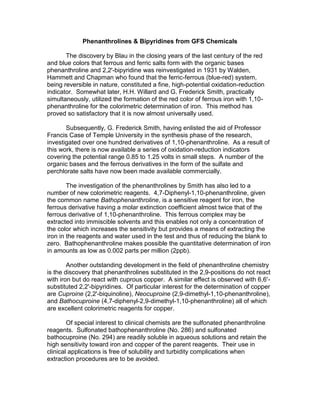
Phenanthrolines & Bipyridines Reagents for Iron & Copper Detection
- 1. Phenanthrolines & Bipyridines from GFS Chemicals<br />The discovery by Blau in the closing years of the last century of the red and blue colors that ferrous and ferric salts form with the organic bases phenanthroline and 2,2'-bipyridine was reinvestigated in 1931 by Walden, Hammett and Chapman who found that the ferric-ferrous (blue-red) system, being reversible in nature, constituted a fine, high-potential oxidation-reduction indicator. Somewhat later, H.H. Willard and G. Frederick Smith, practically simultaneously, utilized the formation of the red color of ferrous iron with 1,10-phenanthroline for the colorimetric determination of iron. This method has proved so satisfactory that it is now almost universally used.<br />Subsequently, G. Frederick Smith, having enlisted the aid of Professor Francis Case of Temple University in the synthesis phase of the research, investigated over one hundred derivatives of 1,10-phenanthroline. As a result of this work, there is now available a series of oxidation-reduction indicators covering the potential range 0.85 to 1.25 volts in small steps. A number of the organic bases and the ferrous derivatives in the form of the sulfate and perchlorate salts have now been made available commercially.<br />The investigation of the phenanthrolines by Smith has also led to a number of new colorimetric reagents. 4,7-Diphenyl-1,10-phenanthroline, given the common name Bathophenanthroline, is a sensitive reagent for iron, the ferrous derivative having a molar extinction coefficient almost twice that of the ferrous derivative of 1,10-phenanthroline. This ferrous complex may be extracted into immiscible solvents and this enables not only a concentration of the color which increases the sensitivity but provides a means of extracting the iron in the reagents and water used in the test and thus of reducing the blank to zero. Bathophenanthroline makes possible the quantitative determination of iron in amounts as low as 0.002 parts per million (2ppb).<br />Another outstanding development in the field of phenanthroline chemistry is the discovery that phenanthrolines substituted in the 2,9-positions do not react with iron but do react with cuprous copper. A similar effect is observed with 6,6'-substituted 2,2'-bipyridines. Of particular interest for the determination of copper are Cuproine (2,2'-biquinoline), Neocuproine (2,9-dimethyl-1,10-phenanthroline), and Bathocuproine (4,7-diphenyl-2,9-dimethyl-1,10-phenanthroline) all of which are excellent colorimetric reagents for copper.<br />Of special interest to clinical chemists are the sulfonated phenanthroline reagents. Sulfonated bathophenanthroline (No. 286) and sulfonated bathocuproine (No. 294) are readily soluble in aqueous solutions and retain the high sensitivity toward iron and copper of the parent reagents. Their use in clinical applications is free of solubility and turbidity complications when extraction procedures are to be avoided.<br />The six most sensitive iron reagents available are now included in our list, PPT,2,4-BDTP and PPDT and their sulfonated derivatives. These reagents are the latest in the continuing efforts of Case and Schilt to find the very best. The sulfonated reagents can be substituted in nearly any procedure using sulfonated bathophenanthroline or sulfonated PDT by merely changing the wavelengths used.<br />Two reagents are available for the determination of iron in highly alkaline solutions: 4,7-dihydroxy-1,10-phenanthroline and phenyl-2-pyridyl ketoxime. Strictly the latter is not a phenanthroline, but it does have a resemblance in structure to the phenanthrolines. Both compounds form red colors with ferrous iron, even in concentrated sodium hydroxide solution. That with phenyl-2-pyridyl ketoxime may be extracted with isoamyl alcohol. Phenyl-2-pyridyl ketoxime reacts with oxidized forms of iron (Fe2O3, Fe3O4, etc.) in alkaline solution but not with metallic iron and it may be used to differentiate quot; oxidizedquot; iron from metallic iron. Both reagents may be used for the direct determination of iron in fixed alkalies and in the leach waters following alkaline fusions.<br />A material closely related to the bipyridines, 2,4,6-tripyridyl-1,3,5-triazine (abbreviated TPTZ), has been introduced by Case, Collins, Diehl and Smith as a reagent for iron. It has the sensitivity toward iron of bathophenanthroline and the blue color of the ferrous derivative is extractable into nitrobenzene. It has been applied to the determination of iron in limestone, silicates, burnt refractories, wine, sea water and other substances. It is easier to prepare than bathophenanthroline and is therefore less expensive.<br />Another compound closely related to the bipyridines, 3-(2-pyridyl)-5,6-diphenyl-1,2,4-triazine (abbreviated PDT), was recently introduced as a reagent in a new technique for the simultaneous determination of iron and copper. Applied to the analysis of milk, wine, and water, the method proved to be highly sensitive, simple in execution, and accurate for both iron and copper.<br />The phenanthrolines are finding other uses also: in analytical chemistry for the precipitation of anions (perchlorate and tungstate), as scavenging agents for the recovery of traces of metals, in industrial work as paint driers, and biochemistry as enzyme inhibitors.<br />The phenanthroline and bipyridine reagents are difficult to prepare and appear costly by the gram. One gram of material, however, serves for several hundreds of analyses and the unit cost is but a penny or less per determination. Saving in time, increase in accuracy, and reduction on labor costs make the use of these reagents highly attractive.<br />For further details of the chemistry and uses of these reagents the reader is referred to the monograph by A.A. Schilt, Analytical Applications of 1,10-Phenanthroline and Related Compounds, Pergamon Press, New York, NY, and (Nos. 205, 217, 218, and 219).<br />Contact GFS Chemicals 800-858-9682 or e-mail service@gfschemicals.com or visit us on the web at www.gfschemicals.com<br /> <br />